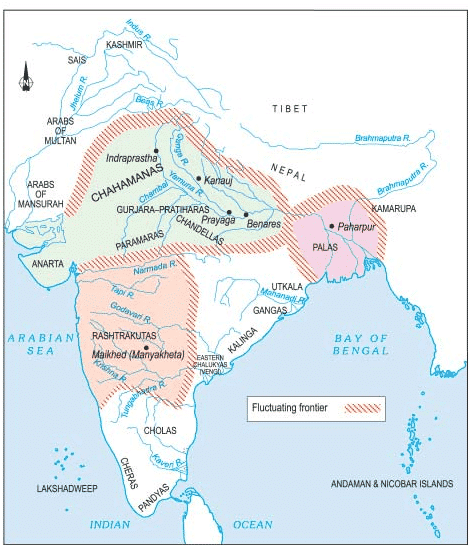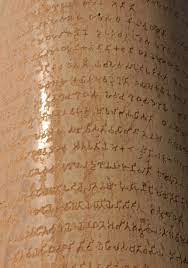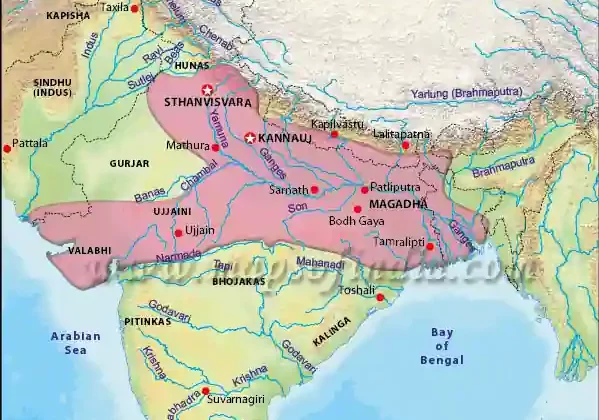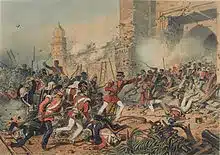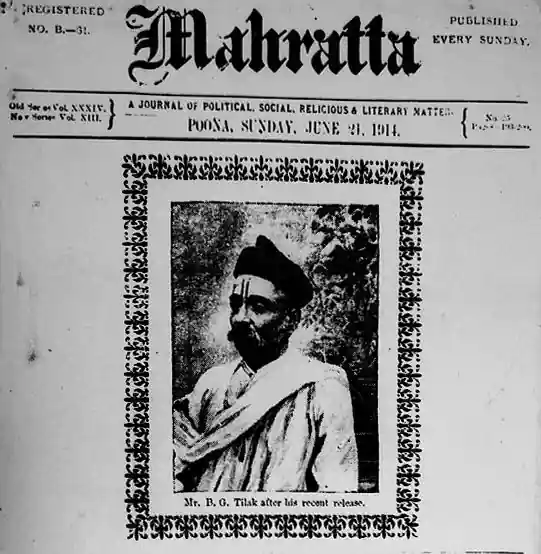Vakataka Dynasty
By the third century, the Satavahanas had collapsed and the Sakas were no longer the powerful force they had been. The stage was set in the Deccan for a local power to stake its claim. It is in this scenario that Vindhyashakti, a Brahmin chieftain about whom not much is known, founded the Vakataka empire.
Most of the information that we have regarding the chronology and the rulers has been constructed through the Puranas and other records and inscriptions.
The Vakatakas were the contemporaries of the Guptas in northern India.
- In the Puranas, the Vakatakas are referred to as the Vindhyakas.
- The Vakataka kingdom extended from the southern extremities of Malwa and Gujarat in the north to the Tungabhadra River in the south, and from the Arabian Sea in the west to the edges of Chhattisgarh in the east.
- The Vakatakas belonged to the Vishnuvriddha gotra of the Brahmanas and performed numerous Vedic sacrifices.
- A large number of copperplate land grant charters issued by the Vakatakas to the Brahmans have helped in reconstructing their history.
- They were Brahmins and promoted Brahmanism, however, they also patronised Buddhism.
- Culturally, the Vakataka kingdom became a channel for transmitting Brahmanical ideas and social institutions to the south.
- The Vakatakas entered into matrimonial alliances with the Guptas (Rudrasena II of the royal Vakataka family was married to Prabhavatigupta, the daughter of Chandragupta II of the imperial Gupta family), the Nagas of Padmavati, the Kadambas of Karnataka and the Vishnukundins of Andhra.
- The Vakatakas patronised art, culture and literature. Their legacy in terms of public works and monuments have made significant contributions to Indian culture.
- Under the patronage of the Vakataka king, Harisena, the rock-cut Buddhist Viharas and Chaityas of the Ajanta caves (World Heritage Site) were built.
- Ajanta cave numbers ⅩⅥ, ⅩⅦ, ⅩⅨ are the best examples of Vakataka excellence in the field of painting, in particular the painting titled Mahabhinishkramana.
- Vakataka kings, Pravarasena Ⅱ (author of the Setubandhakavya) and Sarvasena (author of Harivijaya) were exemplary poets in Prakrit.
- During their rule, Vaidharbhariti was a style developed in Sanskrit which was praised by poets of the likes of Kalidasa, Dandin and Banabhatta.
Rulers of the Vakataka Dynasty
Vindhyashakti (Reign: 250 – 270 CE)
- Founder of the Vakataka dynasty.
- Probably ruled from Purika.
- He is credited to have performed a number of Vedic sacrifices and thus revived Brahminical rituals, which were in abeyance during the rule of the later Satavahanas.
- The Ajanta Inscriptions of the time of Harisena describes him as a dvija and praises him for his military achievements.
- It is claimed that the sun was obscured by the masses of dust raised by his horses’ hooves, and he is compared with the gods Puramdara (Indra) and Upendra (Vishnu).
Pravarasena I (Reign: 270 – 330 AD)
- Son and successor of Vindhyashakti.
- The founder of the real power and greatness of the Vakatakas.
- His other titles include Samrat, Dharmamaharaja and Haritiputra.
- He conducted Vedic rituals like Ashwamedha, Vajapeya, etc.
- He enlarged his empire southwards into Vidarbha and adjoining areas of the Deccan, with his capital at Kanchanaka (modern Nachna).
- His son Gautamiputra married the daughter of the Naga king Bhavanaga, which formed an important political alliance.
- With the help of matrimonial alliances and military power, he extended his empire from Bundelkhand in the north to Hyderabad in the south.
- To celebrate his victories, he performed an asvamedha and a vajapeya sacrifice.
- He adopted the title “Samrat” while all other Vakataka kings took the title of “Maharaja”.
- After the death of Pravarasena, his four sons divided the empire and ruled independently in separate provinces.
- After his death, there were two divisions of the Vakatakas.
- Pravarapura-Nandivardhana Branch [Nandivardhana – modern Nagpur]
- Vatsagulma Branch [Modern Washim, Akola district, Maharashtra]
- His son Gautamiputra died before him and his grandson (son of Gautamiputra) Rudrasena I succeeded him to the throne and ruled from Nandivardhana.
- Sarvasena, another son of Pravarasena, ruled independently from Vatsagulma.
- We do not have adequate knowledge of the two other sons of Pravarasena.
- In spite of these divisions in the Vakataka kingdom, the contemporary Gupta rulers never attacked the Vakatakas. This may be due to the Guptas’ belief that the Vakatakas could be useful to them in defeating the Western Kashtrapas.
Pravarapura-Nandivardhana Branch
This branch ruled over Pravarapura (in present Wardha, Maharashtra), Mansar and Nandivardhan in the present Nagpur district.
Rudrasena I (Reign: 340 – 365 CE)
- Grandson of Pravarasena I.
- Founder of the Nandivardhana branch of the Vakataka kingdom.
- Since no inscription belonging to his reign is available, not much is known about the events that took place during his reign.
- He was a worshipper of Lord Mahabhairava, the fierce form of Shiva.
Prithvisena Ⅰ (c. 365 – 390 CE)
- In Vakataka inscriptions, he was compared to the epic hero Yudhishthira due to his comparable qualities of truthfulness, compassion and humility.
- Padmapura was an important administrative centre during his reign.
- The political alliance with Chandragupta Ⅱ was an important feature of his reign and together they defeated the Shaka Satraps of Malwa and Kathiawar.
- Guptas and Vakatakas strengthened their bond by a marriage alliance between Rudrasena Ⅱ (Prithvisena’s son) and Prabhavatigupta (daughter of Chandragupta Ⅱ).
- Followed Shaivism like his father.
Rudrasena II (Reign: 390 – 395 CE)
- Son of Prithvisena I.
- Married Prabhavatigupta, daughter of Chandragupta II.
- He ruled for only five years leaving behind his three sons – Divakarasena, Damodarasena and Pravarasena.
- His wife Prabhavatigupta ruled as the regent until 410 CE.
- The seal of Prabhavatigupta’s Maregaon plates describes her as the ‘mother of two kings’ because her elder son Divakarasena did not live long enough to ascend the throne but both her younger sons did rule.
Pravarasena II (Reign: 395 – 440 CE)
One of the major decisions taken by Pravarasena II, who had a long rule of about 30 years from 410 CE to 440 CE, was to shift the capital of the empire to a new city called Pravarapura, probably near Wardha. Until then, Nandivardhana – known today as Nagardhan – was the capital city.
- He succeded his brother Damodarasena.
- Largest number of Vakataka inscriptions belong to his reign.
- A dozen copper-plate grants of his were discovered in different parts of Vidarbha.
- He is credited with the founding of a new capital at Pravarapura, which is identified as Paunar in the present day Wardha district.
- Even though he was a devotee of Shiva, he composed a Prakrit kavya glorifying Rama, the Setubandha/Ravanavaha, which is about Rama’s journey to Lanka and his victory over Ravana.
- He entered into a matrimonial alliance with the contemporary Kadambas (near Mysore).
- His son Narendrasena was married to a princess of Kuntala, Ajihata Bhattarika, the daughter of Kakutsavarman of the Kadamba dynasty.
Narendrasena (c. 440 – 460 CE)
- It is believed that after the death of Pravarsena II, a struggle for succession happened in which Narendrasena emerged successful.
- He had to face the invasion of the Nala king, Bhavadottavarman, both in the beginning and at the end of his reign.
- In between, he made some conquests, and had to face the stiff opposition of the Nalas all along.
- He was married to Ajihata Bhattarika, the daughter of Kakutsavarman of the Kadamba dynasty.
Prithvisena Ⅱ (c. 460 – 480 CE)
- Last known ruler of the Nandivardhana branch of the Vakataka dynasty.
- His inscriptions refer to his having twice rescued the sunken fortunes of Vakatakas.
- He had to face the invasion of Harisena of the Vatsagulma line thrice, and the invasion of Bhavadottavarman of the Nala dynasty. It appears that he had to fight with the Traikutaka king, Dahrasena of southern Gujarat as well.
- After his death, it is presumed that Harisena of the Vatsagulma branch of the Vakatakas conquered his successors and united the Nandivardhana branch with his own.
Vatsagulma Branch
- The second major Vakataka line was the Vatsagulma branch, which had its capital at Vatsagulma (modern Washim in Akola district, Maharashtra).
- This branch ruled over the territory between the Sahyadri Range and the Godavari River.
- The founder of the Vatsagulma line of the Vakatakas was Sarvasena, the son of Pravarasena I.
Sarvasena (Reign: 330 – 355 CE)
- Son of Pravarasena I.
- Adopted the title dharma-maharaja.
- Was believed to be a renowned Prakrit poet, and his lost work, the Harivijaya, was lauded by later writers.
- Some of his verses were incorporated into the Gathasattasai.
Vindyashakti Ⅱ/Vindhyasena (c. 355 – 400 CE)
- He ruled for almost four decades and his kingdom seems to have included the Marathwada region comprising of the southern part of Vidarbha, the northern part of Hyderabad state, and some other adjoining territories.
- He is believed to have defeated the Kadambas of Banavasi, who ruled over Kuntala (north Karnataka).
- His son and successor Pravarasena II appears to have ruled for a period of fifteen years. Pravarasena II was followed by Devasena, who was a pleasure-seeking ruler, but luckily had the services of a very capable minister, Hasthibhoja.
- His successor Harisena was the ablest and the greatest ruler of this line.
Harisena (Reign: 475 – 500 AD)
- Last known king of the Vatsagulma line, who not only united the two Vakataka branches but also extended his territories by conquering Kuntala, Avanti, Kalinga, Kosala, Konkan, and Andhra.
- His kingdom extended from Malwa in the north to southern Maharashtra in the south, and from the Bay of Bengal in the east to the Arabian Sea in the west.
- Dandin, a poet of the 6th century CE, described Harisena as “powerful, truthful and bountiful, glorious, lofty, and a penetrating critic of ethical and economic compendia”.
- The Thalner copper plates (which record the gifts of villages of bronze workers and goldsmiths) belong to his rein and many of the Ajanta caves were executed during his reign.
- In one of the inscriptions at cave XVI and the Ghatotkacha cave, there is mention of his minister Varahadeva.
- With the death of Harisena II, the glory of the Vakatakas ended and the Nalas, the Kadambas, the Kalachuris, and Yasodharman of Malwa occupied their territory.
The Vakataka dynasty disappeared soon after the death of King Harisena. Most of the regions occupied by the Vakatakas had been taken over by the Chalukyas by 550 CE. But, how and why this decline and disappearance occurred remains a mystery.
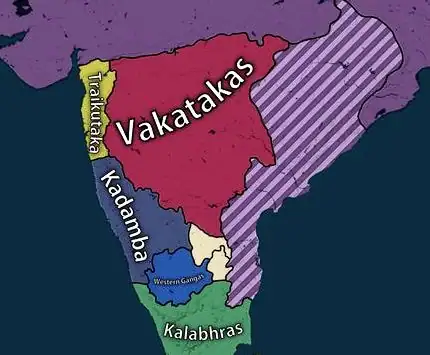
Economy
- The Vakatakas patronised the economy by promoting the expansion of agriculture.
- They gave innumerable land donations to Brahmins and officers of the state.
- They were given cultivable waste lands which in the long term led to feudalism.
- The Vakataks in turn got the support of the feudal lords.
Religion
- The Vakataks were patrons of the given brahmanical religion.
- Devotees of Vishnu and Shiva.
- The Vakatakas performed various sacrifices and patronized Hindu culture.
- But they continued protection to Buddhist and Jain traders.
Literature
- Vakatakas used the Prakrit language for their inscription.
- Kings like Pravarasena II (celebrated author of the Setubandhakavya) and Sarvasena (author of the Harivijaya) were themselves poets of great repute in Prakrit.
- A style by the name of Vaidharbhariti was developed in Sanskrit during their rule, which was praised by the poets of the likes of Kalidasa, Banabhatta, and Dandin.
- The Vakatakas had a stamp of their own in their rulership, which is truly unmatched.
Painting
- They made a remarkable contribution in the field of painting.
- Ajanta cave numbers XVI, XVII and XIX are the best examples of Vakataka excellence in the field of painting, in particular the painting titled Mahabhinishkramana.
- Not only the Vakataka rulers, but their ministers or governors like Hastibhoja and Varahadeva also extended their benevolent patronage to the Ajanta cave painters.
Architecture
- The rock-cut Buddhist viharas and chaityas of the Ajanta Caves (a UNESCO World Heritage Site) were built under the patronage of the Vakataka king, Harisena.
- The Vakatakas oversaw the construction of many Brahmanical temples during their reign.
- They are also credited with having built a few temples in Tigwa and Nachanakuthara.


